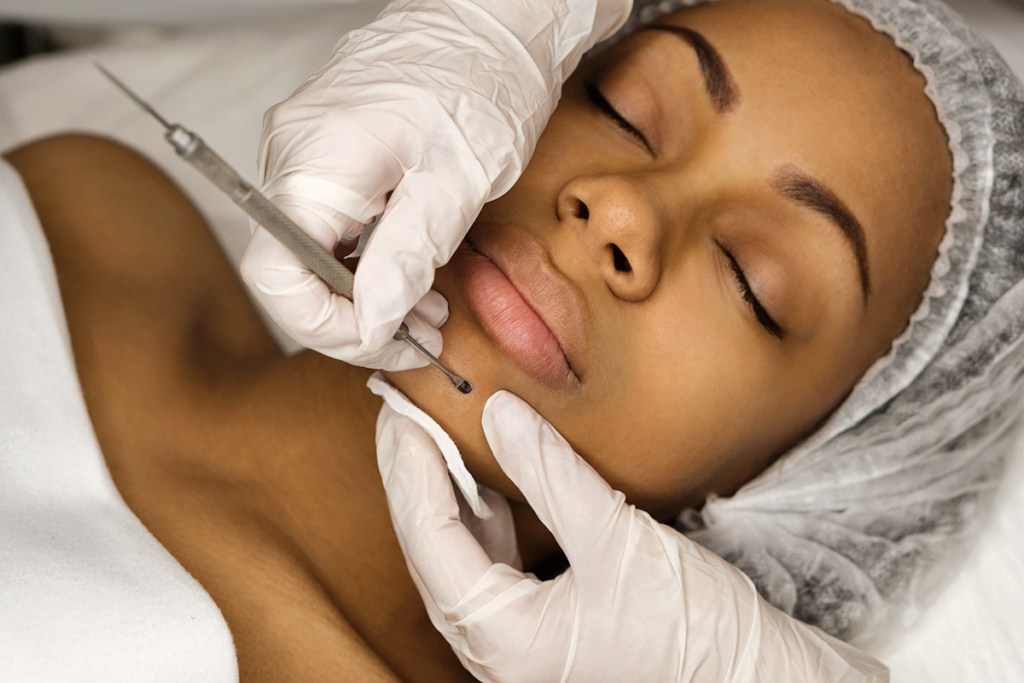What is a facial with extractions? A facial with extractions is a skin treatment designed to deeply cleanse pores and remove blockages like blackheads and whiteheads. It’s a more intensive treatment than a standard facial, focusing specifically on clearing out congested pores. Read on to find out more!

Image Source: dermsos.com
Diving Deep into Facials with Extractions
Facials with extractions are specialized skincare treatments that go beyond surface-level cleansing. They aim to improve the skin’s clarity and texture by removing impurities trapped within the pores. This type of facial is particularly beneficial for individuals struggling with acne, blackheads, whiteheads, and other forms of congestion. Let’s explore what this process entails.
Dissecting the Comedone Extraction Procedure
The comedone extraction procedure is the core of a facial with extractions. A comedone is simply a blocked hair follicle, which can manifest as a blackhead (open comedone) or a whitehead (closed comedone). The procedure involves several key steps:
- Cleansing: The esthetician begins by thoroughly cleansing the skin to remove surface dirt, oil, and makeup.
- Exfoliation: This step helps to loosen dead skin cells that can contribute to clogged pores. Exfoliation can be achieved through physical scrubs, chemical peels, or enzyme treatments.
- Steaming: Steam is used to soften the skin and open up the pores, making extractions easier and less painful.
- Extractions: This is the heart of the process. Using sterile tools or gloved fingers, the esthetician gently applies pressure around the comedone to dislodge the blockage.
- High-Frequency Treatment (Optional): High-frequency is sometimes used after extractions to kill bacteria, reduce inflammation, and promote healing.
- Mask and Moisturizer: A soothing mask is applied to calm the skin, followed by a moisturizer to hydrate and protect.
Examining Esthetician Extraction Techniques
Estheticians employ various techniques to safely and effectively perform extractions. These techniques are crucial to minimize trauma to the skin and prevent scarring. Here are some common methods:
- Manual Extraction: Using gloved fingers wrapped in sterile gauze or cotton, the esthetician applies gentle pressure around the comedone to push out the blockage. This technique is often preferred for larger or more stubborn comedones.
- Comedone Extractor Tool: This tool has a small loop or cup at the end, which is placed around the comedone. Gentle pressure is then applied to extract the blockage. There are many different shapes and sizes depending on which esthetician is using them. This tool can be more precise and efficient for certain types of extractions.
- Lancet: In some cases, particularly with closed comedones (whiteheads), a sterile lancet may be used to create a small opening in the skin, allowing the esthetician to access and extract the blockage. This should only be performed by a trained professional.
It’s important to note that not all blemishes are suitable for extraction. Inflamed pimples or cysts should not be extracted, as this can worsen inflammation and potentially lead to scarring. Your esthetician will assess your skin and determine which blemishes are safe to extract.
The Benefits of Extractions for Skin
The benefits of extractions extend beyond simply clearing out clogged pores. They can significantly improve the overall health and appearance of your skin. Here are some key facial extractions benefits:
- Clearer Skin: By removing blackheads, whiteheads, and other debris, extractions help to clear up the complexion and reduce the appearance of blemishes.
- Smaller Pores: When pores are clogged, they can appear enlarged. Removing the blockages helps to minimize the appearance of pores.
- Improved Skin Texture: Extractions can smooth the skin’s surface by removing bumps and rough patches caused by clogged pores.
- Reduced Acne Breakouts: By preventing the buildup of oil and dead skin cells, extractions can help to reduce the frequency and severity of acne breakouts.
- Better Product Absorption: When pores are clear, skincare products can penetrate more effectively, delivering their active ingredients to the skin.
A Detailed Exploration of the Acne Extraction Process
The acne extraction process is a specific type of extraction that focuses on removing comedones and other impurities that contribute to acne breakouts. This process is often incorporated into a comprehensive facial for acne-prone skin with extractions. Here’s a closer look:
- Consultation: The esthetician will assess your skin type, acne severity, and any other relevant factors to determine the best course of treatment.
- Deep Cleansing: A thorough cleansing is essential to remove surface impurities and prepare the skin for extractions.
- Exfoliation: Exfoliating with a gentle enzyme or chemical exfoliant helps remove dead skin cells that can clog pores.
- Steaming: Steam softens the skin and opens the pores, making extractions easier and less painful.
- Extractions: Using sterile tools or gloved fingers, the esthetician carefully extracts comedones, blackheads, and whiteheads.
- High-Frequency Treatment (Optional): High-frequency can help to kill bacteria and reduce inflammation after extractions.
- Mask: A clay-based or sulfur-based mask may be applied to further draw out impurities and soothe the skin.
- Hydration & Protection: A light, oil-free moisturizer is applied to hydrate the skin, followed by sunscreen to protect it from the sun.
Deciphering Professional Skin Cleansing with Extractions
Professional skin cleansing with extractions is a more advanced form of cleansing that goes beyond what you can achieve at home. It involves the use of professional-grade products and tools, as well as the expertise of a trained esthetician. Here are some key differences between professional and at-home cleansing:
| Feature | Professional Cleansing with Extractions | At-Home Cleansing |
|---|---|---|
| Depth | Deeper, more thorough | Surface-level |
| Products | Professional-grade, higher concentration | Over-the-counter |
| Tools | Sterile tools for extractions | None |
| Expertise | Trained esthetician | Self-administered |
| Results | More significant and long-lasting | Temporary and limited |
| Risk of Damage | Low (when performed by a professional) | Higher (if done incorrectly) |
Analyzing Clogged Pore Treatment Facial
A clogged pore treatment facial is specifically designed to address the root cause of breakouts and congestion: clogged pores. The primary goal is to remove the buildup of oil, dead skin cells, and debris that can lead to blackheads, whiteheads, and acne. Here’s what you can expect from this type of facial:
- Assessment: The esthetician will examine your skin to determine the extent of pore congestion and identify any underlying issues.
- Deep Cleansing: A double cleanse is often performed to ensure that all traces of dirt, oil, and makeup are removed.
- Exfoliation: Exfoliation is a crucial step in unclogging pores. Chemical peels, enzyme treatments, or microdermabrasion may be used to remove dead skin cells and promote cell turnover.
- Steam: Steam helps to soften the skin and open the pores, making extractions easier and more effective.
- Extractions: The esthetician will carefully extract comedones and other impurities from clogged pores.
- Mask: A clay-based or charcoal mask may be applied to draw out impurities and absorb excess oil.
- Hydration: A lightweight, non-comedogenic moisturizer is applied to hydrate the skin without clogging pores.
What to Expect During Your Facial With Extractions
Knowing what to expect during your facial with extractions can help you feel more relaxed and prepared. Here’s a general overview of what you can anticipate:
- Consultation: Your esthetician will start with a consultation to discuss your skin concerns, medical history, and any medications you are taking.
- Cleansing: Your skin will be thoroughly cleansed to remove any makeup, dirt, or oil.
- Exfoliation: A gentle exfoliant will be used to remove dead skin cells and prepare your skin for extractions.
- Steaming: Your face will be exposed to steam for several minutes to soften the skin and open up the pores.
- Extractions: The esthetician will perform extractions using sterile tools or gloved fingers. This may involve some discomfort, but it should not be excessively painful.
- High-Frequency Treatment (Optional): A high-frequency device may be used to kill bacteria and reduce inflammation after extractions.
- Mask: A soothing mask will be applied to calm and hydrate your skin.
- Moisturizer and Sunscreen: Your treatment will conclude with the application of a moisturizer and sunscreen.
Post-Facial With Extractions Care: What You Need To Know
Proper aftercare is essential to maximize the benefits of your facial with extractions and minimize the risk of complications. Here are some important guidelines to follow:
- Avoid touching your face: Your hands can transfer bacteria to your freshly cleansed skin, increasing the risk of breakouts.
- Don’t pick or squeeze: Resist the urge to pick at any remaining blemishes. This can lead to inflammation, scarring, and infection.
- Use gentle skincare products: Avoid harsh cleansers, exfoliants, and other irritating products for at least 24-48 hours after your facial.
- Stay hydrated: Drink plenty of water to help your skin heal and stay hydrated.
- Protect your skin from the sun: Apply sunscreen with an SPF of 30 or higher every day, even on cloudy days.
- Avoid wearing makeup: Give your skin a break from makeup for at least 24 hours after your facial.
- Follow your esthetician’s instructions: Your esthetician may provide specific recommendations based on your skin type and the treatment you received.
Potential Side Effects of Extractions: How to Minimize Risks
While facials with extractions are generally safe, some potential side effects can occur. These side effects are usually mild and temporary, but it’s important to be aware of them:
- Redness: Redness is common after extractions, especially in sensitive areas. It usually subsides within a few hours.
- Swelling: Some swelling may occur, particularly if extractions were performed on inflamed areas. This should also resolve within a day or two.
- Breakouts: It’s possible to experience a temporary breakout after extractions. This is often due to trapped impurities being brought to the surface.
- Dryness: Your skin may feel dry or tight after extractions. Be sure to use a gentle moisturizer to hydrate your skin.
- Scarring: Scarring is rare, but it can occur if extractions are performed improperly or if you pick at your skin afterward.
To minimize the risk of side effects, it’s crucial to choose a qualified and experienced esthetician. You should also follow all aftercare instructions carefully.
Are Facials With Extractions Right For You?
Facials with extractions can be a beneficial treatment for many skin types, but they’re not right for everyone. Here’s a look at who can benefit most:
- Acne-prone skin: Extractions can help to clear clogged pores and reduce the frequency and severity of acne breakouts.
- Oily skin: If you have oily skin, extractions can help to remove excess oil and prevent clogged pores.
- Combination skin: Extractions can be targeted to specific areas of your face that are prone to congestion, such as the T-zone.
- Individuals with blackheads and whiteheads: Extractions are the most effective way to remove these types of blemishes.
However, facials with extractions may not be suitable for individuals with:
- Inflamed acne: Extractions should not be performed on inflamed pimples or cysts, as this can worsen inflammation and lead to scarring.
- Rosacea: Extractions can irritate sensitive skin and exacerbate rosacea symptoms.
- Eczema: Extractions can trigger eczema flare-ups.
- Very sensitive skin: If you have very sensitive skin, extractions may be too harsh.
If you’re unsure whether a facial with extractions is right for you, consult with a dermatologist or licensed esthetician.
FAQs About Facials with Extractions
Can I perform extractions at home?
While it might be tempting to extract blemishes yourself, it’s generally not recommended. At-home extractions can be risky, as you may not have the proper tools or knowledge to perform them safely and effectively. Improper extractions can lead to inflammation, scarring, and infection. It’s best to leave extractions to a trained professional.
Who is qualified to perform extractions?
Only licensed estheticians or dermatologists should perform extractions. These professionals have the knowledge, training, and tools necessary to perform extractions safely and effectively. They also understand how to assess the skin and determine which blemishes are suitable for extraction.
How often should I get a facial with extractions?
The frequency of facials with extractions depends on your skin type and concerns. Generally, most people can benefit from a facial with extractions every 4-6 weeks. However, if you have severe acne or very oily skin, you may need to get them more frequently. Your esthetician can recommend a suitable schedule based on your individual needs.
Are extractions painful?
Extractions can cause some discomfort, but they shouldn’t be excessively painful. The level of discomfort depends on your pain tolerance, the type of blemishes being extracted, and the technique used by the esthetician. Most people find the discomfort to be manageable.
Will extractions leave scars?
Scarring is rare after extractions, but it can occur if extractions are performed improperly or if you pick at your skin afterward. To minimize the risk of scarring, choose a qualified esthetician and follow all aftercare instructions carefully.
What’s the difference between a facial and a facial with extractions?
A standard facial focuses on cleansing, exfoliating, and hydrating the skin. A facial with extractions includes all of these steps, plus the added benefit of manual extractions to remove blackheads, whiteheads, and other impurities from the pores. Facials with extractions are more intensive and are specifically designed to address congested pores and breakouts.

I’m Carrie Kelly, the creator behind Gotham Beauty Lounge. Beauty is my passion, and I’ve made it my mission to bring you all the latest trends, expert tips, and honest reviews to help you elevate your beauty game. With a love for all things bold, edgy, and elegant, I believe makeup is an art form, and skincare is self-care. On my blog, I share my personal experiences, favorite products, and advice for embracing your unique beauty. Join me on this exciting journey to feel confident, empowered, and, most importantly, to always look and feel your best!
